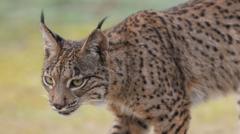The Iberian lynx is experiencing a resurgence, with conservation experts touting its return from the brink of extinction as a major success story. In the early 2000s, the lynx population dwindled to fewer than 100 individuals in isolated groups, starkly illustrating the dire threats posed by habitat loss, vehicle strikes, and a dramatic decline in their primary food source—wild rabbits.
As of today, over 2,000 Iberian lynxes roam the wild in Spain and Portugal, significantly increasing the chances of encountering these magnificent creatures. Rodrigo Serra, who oversees the lynx reproduction program across the Iberian Peninsula, recalls a time when the species faced extinction levels comparable only to the ancient sabre-tooth tiger.
The lynx's precarious fate largely stemmed from agricultural expansion and devastating rabbit epidemics, which decimated prey populations by nearly 95%. Portugal witnessed its last lynx vanish by 2005, the same year Spain recorded the first lynx litter born in captivity. This sparked a national plan that led to the establishment of a National Breeding Centre in Silves, Algarve, designed to facilitate the rehabilitation and preparation of lynxes for life back in the wild.
At the breeding center, the lynxes are closely monitored by staff who employ various techniques to ensure they adapt to life away from humans. Serra describes how certain tactics, including creating noises that mimic potential threats, help teach lynx cubs to avoid close encounters with people. This approach is vital not just for the animals' survival but also to maintain harmony between lynxes and local communities.
Pedro Sarmento, in charge of the reintroduction program in Portugal, has spent 30 years studying the Iberian lynx. He notes their unique physical attributes, such as small heads relative to their bodies and large paws, which enhance their agility and jumping ability.
While the reintroduction of the lynx has largely been deemed successful, concerns have emerged as their population rises. Lynxes occasionally venture onto private land, leading to negotiations with landowners to safeguard livestock from predation, particularly chickens. In response to local unease, measures have been put in place to strengthen chicken coops, and a monitoring system is employed to manage lynx movements.
The journey of Lítio, an early reintroduced lynx, illustrates the complexities of reintegration. After evading tracking for months and traveling back to Spain, Lítio eventually settled in the Algarve for a fresh start and has since fathered numerous cubs.
Three decades after these conservation efforts commenced, the Iberian lynx population is no longer classified as endangered, with hopes for a stable status projected for 2035, contingent upon growing numbers to between 5,000 and 6,000 individuals in the wild. Despite earlier losses attributed mainly to road fatalities, conservationists remain optimistic about the future of the Iberian lynx, able to witness their daily lives through the lens of camera traps.



















